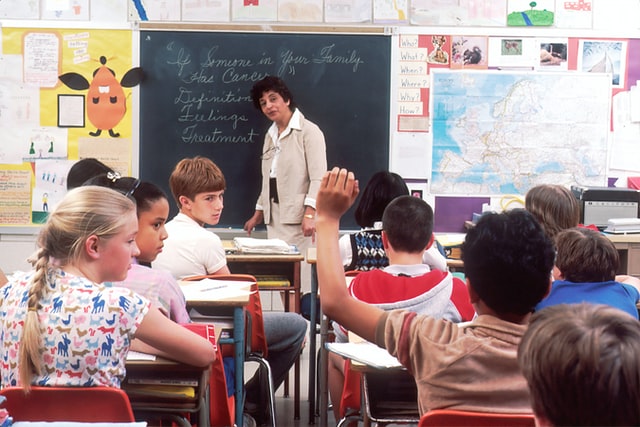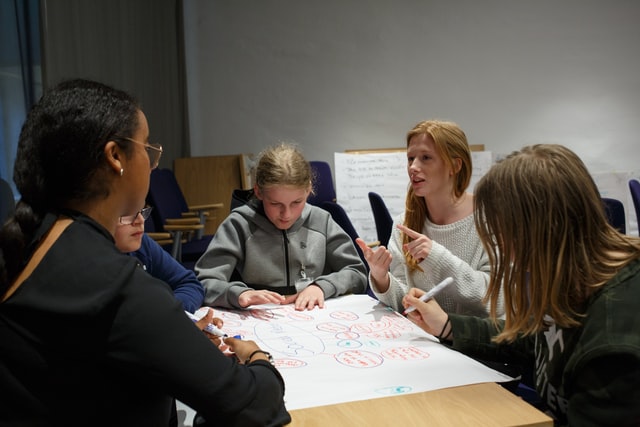“Tell me and I forget.
Teach me and I remember.
Involve me and I learn”
What is Cooperative Learning?
Cooperative Learning is an instructional method in which students work in small groups to accomplish a common learning goal under the guidance of the teacher.
Cooperative learning strategies offer students the possibility to learn by applying knowledge in an environment more similar to the one they will encounter in their future work life.
Teachers get the chance to work on core competencies and on students’ communication and soft skills, which are valuable for students’ success in life and work, integrating them in school curricula.
Cooperative learning strategies are content-free structures that can be reused in different school contexts and we are going to learn how to use some of them.
Strategies can be used both in pairs and groups and are designed to fulfill all the so-called PIES principles: Positive interdependence, Individual accountability, Equal participation and Simultaneous interaction.[1]
Personal Interdepence
In general we talk about positive interdependence when a gain for one is a benefit for the other. Pair and group members experience themselves as a team and are on the same side working toward the same goal.
To ensure positive interdependence while working with cooperative learning, two requisites must be met: students should feel on the same side and the task should require working together.[2]Check out our course on collaborative learning if you wish to know more about how to promote students’ colaboration and engagement in the classroom.

Individual Accountability
In the cooperative classroom, students work together as a team to create and to learn, but ultimately every individual student is responsible for his or her own performance.[3]
It is exactly to fulfill both positive interdependence and individual accountability that in every cooperative learning strategy students are given both time to think/work alone and to interact with peers.
In this way students’ autonomy and cooperation are improved.

Equal Participation
Pair and group work is usually very well welcomed by students, but the problem is that it is difficult to check whether students are equally working.
Cooperative learning strategies instead make sure every student in each team or pair is equally contributing to the final achievement. They are actually designed to make students interact and to have everyone at every step of the activity fulfil a specific task.

Simultaneous Interaction
In sequential interaction, when only one student at a time is engaged, the teacher talks (at least) twice for each time a student talks. And when the teacher is the most active participant in the classroom, students are obviously disengaged (and most likely bored as well).
Cooperative learning strategies on the contrary are designed to produce simultaneous interaction, so to engage as many students as possible simultaneously.[4]

Cooperative Learning and Classroom Management
What teachers soon observe when working with cooperative learning strategies is that working together will offer students the chance to know their classmates better. It also helps to create a better community and therefore a warmer atmosphere in the classroom.
Cooperative learning, reducing students’ disengagement and favoring the natural need of students for social interaction instead of contrasting it, helps also minimize classroom management issues.
Moreover, cooperative learning strategies often offer students a break from the lesson, giving them also the possibility to move around in class.
“Schools on the move” – The Finnish programme
The Finnish programme “Schools on the move”[5], with 90 percent of Finnish schools participating, has proven that implementing short active breaks during the lessons improves the health and wellbeing of students, as well as school enjoyment. And cooperative learning strategies are a great opportunity to engage students in active learning methods involving movement as well.
Using different strategies in class fosters communication among students, and can make the class more meaningful and fun at the same time. Communication skills are recognized to be valuable for students’ future work- and personal life. But yet they are often neglected in school curricula. If you wish to promote your students’ engagement in class, we recommend you check our course and learn how to enhance their communication and social skills through drama techniques.
Are Cooperative Learning Strategies difficult to implement?
Are they time consuming?
Cooperative learning strategies are not only very scalable but most of the time they require very little to no preparation. And some of them last less than 5 minutes, having in this short period of time all students in class being challenged and engaged.
Teachers can start by implementing one single strategy in their own lesson and then evaluate the outcomes in different school classes.
Strategies like Think-Pair-Share or Circle-The-Sage, for example, are not time-consuming at all and do not require a long preparation either.
Think-Pair-Share

Think-Pair-Share is the solution to the situation every teacher encounters when asking a question in class: having the same student(s) answering every single time.
Most of the students do not even feel challenged to think of a possible answer, not to mention speaking up. This happens for many reasons, probably not only due to a lack of knowledge or preparation, but also due to a lack of self-confidence.
Moreover, research on “wait time” reveals that most teachers provide an average of only one second of think time after they ask a question.[6]
Cooperative learning strategies also engage introspective and slower students, who need time before they feel ready to answer.
In Think-Pair-Share the teacher asks a question to the whole class, as he or she would do at the beginning or at some point of the lesson.
Depending on the age and on the level of the students, it could be something that requires personal interpretation at some point or not. Students get some solo time to think about a possible answer- or to write it down- then they turn to their classmate sitting next to them and get some pair-time to share and discuss what they have just found out.
At the end of this activity, the teacher randomly chooses two or three pairs and asks them to briefly share their answers or responses.
No matter how old students are- I have successfully used this strategy not only for small children but even in my teacher training courses– it is astonishing how much mutual interaction deepens their understanding.
Pairs will most of the time succeed where single students would have probably failed.
Think-Pair-Share can also be used to have students reflect on a topic, even when no right interpretation is needed, and, being the simplest and most famous cooperative learning strategy, can be the first one to be implemented.

Circle-the-Sage
Another very effective strategy for engaging students in answering a question is Circle-the-Sage.
The teacher asks a question in class, and then asks every student who can answer it to stand up. All the other students can now choose a classmate and listen to the explanation.
Peer tutoring has proven to be very effective for both sides: high achievers, who are already familiar with content, get the chance to prove it and learn valuable communication skills at the same time.
And teachers surely don’t need to be told how much you can learn by teaching! Students who missed a concept get the chance to listen to another peer explaining.

Timed-Pair-Share

Communication includes not only speaking, reading and writing, but also listening. And it is exactly in practising the latter that the next strategy focuses on.
Timed-Pair-Share is perfect for students to interact and practise the language, so it can be used in every subject where the context is everything and it makes sure every student will talk and listen for the same amount of time.
After having given a topic and some time to think about it, the teacher asks students to pair up and states how long they will share- one or two minutes are a good start. In pairs, partner A shares and partner B listens. To rapidly check if the person who is talking is the one supposed to, partners can hold a pen while sharing. At the end, partners B provide positive responses, like “I enjoyed listening to you because…” or “Your most interesting idea was…” and partner switch roles.[7]
The strategy Timed-Pair-Share makes shy and less talkative students speak up and force everyone to be listening for a specific amount of time. Through this activity, students improve speaking and listening skills equally and get to know their classmates better.
Moreover: listening without the urge to respond helps listeners focusing on the speaker and listening only to understand, which is the definition of active listening.
In second-language instruction Timed-Pair-Share can be used with any possible topic, depending on language proficiency, whether for subjects like history or literature it can be used to ask for opinions or personal interpretations.

Agree-Disagree Line-ups
A good way to involve some movement before starting a Timed-Pair-Share and to make sure students get to talk to everybody else in the classroom and not merely their neighbours is Agree-Disagree Line-ups.
The teacher announces a statement, such as, “I feel my opinion matters in this class” “Taxes should be raised” etc. The strongest ‘agree’ student stands at one end of the line while the strongest ‘disagree’ stands at the other. The remaining students stand between, closer to one end or the other. Through Timed-Pair-Share, students listen carefully to those with a similar point of view (those standing next to them in the line) or the teachers folds the line so they listen to and understand a point of view different from their own.

Rally Coach
“Students are more open to feedback from a peer than feedback from the teacher”.
An effective cooperative learning strategy to implement peer tutoring in class is Rally Coach.
In pairs, students take turns, one student solving problems while talking through their thinking aloud, while the other listens, coaches where necessary and provides positive feedback. Roles are then reversed to do another exercise.
Rally Coach can be used to maximize interaction and feedback when doing exercises in class. Students learn how to work autonomously when solving the exercise, but also how to interact, give and receive feedback from a classmate. Simultaneous interaction is provided, since every student in the class is active at the same time- either in solving the problem or coaching.
Peer tutoring’s downside is that it implies that some students are weaker than others and need therefore some help. Using Rally Coach, low-achievers get the help they need when doing the exercise and learn from high-achievers when coaching.

If you want to learn how to implement these and more cooperative learning strategies, discover our online course “Cooperative and Collaborative Learning: Introducing Teamwork in Education“.
References
- Making Cooperative Learning Work Better – cultofpedagogy.com
- kaganonline.com
- Collaborative learning – Edutopia
[1] Dr. S. Kagan–M. Kagan, Kagan Cooperative Learning, Kagan Publishing, 2009, 4.2.
[2] Dr. S. Kagan-M. Kagan, Ebd., Kagan Publishing, 2009, 12.2.
[3] Dr. S. Kagan-M. Kagan, Ebd., Kagan Publishing, 2009, 12.9.
[4] Dr. S. Kagan-M. Kagan, Ebd., Kagan Publishing, 2009, 12.19-20.
[5] https://liikkuvakoulu.fi/english
[6] Dr. S. Kagan-M. Kagan, Ebd., Kagan Publishing, 2009, 12.17.
[7] Dr. S. Kagan-M. Kagan, Ebd., Kagan Publishing, 2009, 6.84.


So interesting and helpful for my classroom.
Enriching topic!
As a School Guidance Counselor, I find the cooperative learning strategies to promote respect, acceptance, encouragement-of knowledge and helps the student to engage in the “I can” attitude. Therefore, in my opinion, classroom management becomes much more attainable.
Definitely a matter of lack of self-confidence those students who do not raise hands to answer. WILL try think-pair-share.
Thank you for sharing
Thank you very much for sharing such comprehensive topic.
Great information:)
Good ideas
Very helpful article !!
Fantastic information to try on. Timed-Pair-Share is an activiti I would like to try. Thank you.